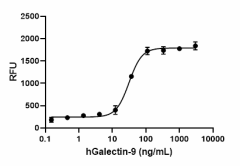- Regulatory Status
- RUO
- Other Names
- HUAT, Lectin, galactoside-binding, soluble, 9 (LGALS9), LGALS9A

-

Immobilized recombinant human Galectin-9 supports the adhesion of Jurkat human acute T cell leukemia cells in a dose-dependent manner. ED50 for this effect is 15 - 75 ng/mL.
| Cat # | Size | Price | Quantity Check Availability | ||
|---|---|---|---|---|---|
| 557302 | 10 µg | $112.00 | |||
| 557304 | 25 µg | $218.00 | |||
| 557306 | 100 µg | $546.00 | |||
Galectin-9 is a member of the lectin family, which includes 15 mammalian lectin members. Like all galectins, Galectin-9 contains a carbohydrate recognition binding domain that enables specific binding of β-galactosides. Most galectins are either bivalent or multivalent in regards to their carbobydrate binding capacity, which enables the recognition of distinct signalling pathways. Galectin-9 may be retained intracellularly or transported to the cell surface where it can be cleaved to generate a soluble form. Galectin-9 functions in effector and regulatory phases of the immune response. During inflammation, the production of Galectin-9 in vivo generates a microenvironment that limits effector T cell responses. Galectin-9 can negatively regulate the Th1 immune response by engaging TIM-3 on T cells, which leads to induction of intracellular Ca2+ influx and activation of apoptosis pathways. In addition, Galectin-9 has been shown to function as a urate transporter in the kidney. Galectin-9 has been identified as a possible prognostic marker in breast cancer, melanoma, and oral squamous cell carcinomas.
Product Details
- Source
- Human Galectin-9, amino acids (Ala2-Thr323) (Accession# NP_002299), was expressed in 293E cells with a N-terminal His tag.
- Molecular Mass
- The 343 amino acid recombinant protein with an N-terminal His tag has a predicted molecular mass of approximately 37.9 kD. The DTT-reduced and non-reduced protein migrate approximately above 60 kD by SDS-PAGE. The predicted N-terminal amino acid is His.
- Purity
- >95%, as determined by Coomassie stained SDS-PAGE.
- Formulation
- 0.22 µm filtered protein solutionis in 20 mM MOPS, 300 mM NaCl, 1 mM EDTA, and in 2 mM DTT.
- Endotoxin Level
- Less than 1.0 EU per µg of protein as determined by the LAL method.
- Concentration
- 10 and 25 µg sizes are bottled at 200 µg/mL. 100 µg size and larger sizes are lot-specific and bottled at the concentration indicated on the vial. To obtain lot-specific concentration and expiration, please enter the lot number in our Certificate of Analysis online tool.
- Storage & Handling
- Unopened vial can be stored between 2°C and 8°C for up to 2 weeks, at -20°C for up to six months, or at -70°C or colder until the expiration date. For maximum results, quick spin vial prior to opening. The protein can be aliquoted and stored at -20°C or colder. Stock solutions can also be prepared at 50 - 100 µg/mL in appropriate sterile buffer, carrier protein such as 0.2 - 1% BSA or HSA can be added when preparing the stock solution. Aliquots can be stored between 2°C and 8°C for up to one week and stored at -20°C or colder for up to 3 months. Avoid repeated freeze/thaw cycles.
- Activity
-
Recombinant human Galectin-9 is able to agglutinate human red blood cells with an ED50 of 0.5 - 2.0 µg/ml.
Immobilized recombinant human Galectin-9 supports the adhesion of Jurkat human acute T cell leukemia cells in a dose-dependent manner. ED50 for this effect is 15 - 75 ng/mL. - Application
-
Bioassay
- Application Notes
-
BioLegend carrier-free recombinant proteins provided in liquid format are shipped on blue-ice. Our comparison testing data indicates that when handled and stored as recommended, the liquid format has equal or better stability and shelf-life compared to commercially available lyophilized proteins after reconstitution. Our liquid proteins are verified in-house to maintain activity after shipping on blue ice and are backed by our 100% satisfaction guarantee. If you have any concerns, contact us at tech@biolegend.com.
- Product Citations
-
Antigen Details
- Structure
- Homodimer.
- Distribution
-
Galectin-9 is expressed by lymphocytes, dendritic cells, neutrophils, eosinophils, astrocytes, endothelial cells, fibroblasts, thymus stromal cells, and epithelial cells.
- Function
- Cell aggregation, adhesion, chemotaxis, apoptosis, suppression of Th1 and Th17 responses, and induction of regulatory T cells. IFN-γ induces galectin-9 expression in fibroblasts, endothelial, and Kupffer cells. IL-1β and IL-5 induces it in astrocytes and eosinophils, respectively.
- Interaction
- Extracellular matrix
- Ligand/Receptor
- Galectin-9 binds to glycans featuring galactose and its derivatives, CD444, TIM-3
- Bioactivity
- Human Galectin-9 is able to agglutinate human red blood cells.
- Biology Area
- Apoptosis/Tumor Suppressors/Cell Death, Cell Adhesion, Cell Biology, Cell Motility/Cytoskeleton/Structure, Immunology, Stem Cells
- Molecular Family
- Adhesion Molecules, Immune Checkpoint Receptors
- Antigen References
-
1. Toscano MA, et al. 2009. Nat. Immunol. Rev. 9:338.
2. Hadari YR, et al. 2000. J. Cell Sci. 113:2385.
3. Tsuboi Y, et al. 2007. Clin. Immunol. 124:221.
4. Zhu C, et al. 2005. Nat. Immunol. 6:1245.
5. Wu C, et al. 2014. Immunity 41:270.
6. Graessler J, et al. 2000. Adv. Exp. Med. Biol. 486:179.
7. Bacigalupo ML, et al. 2013. World J. Gastroenterol. 47:8831.
- Gene ID
- 3965 View all products for this Gene ID
- UniProt
- View information about Galectin-9 on UniProt.org
